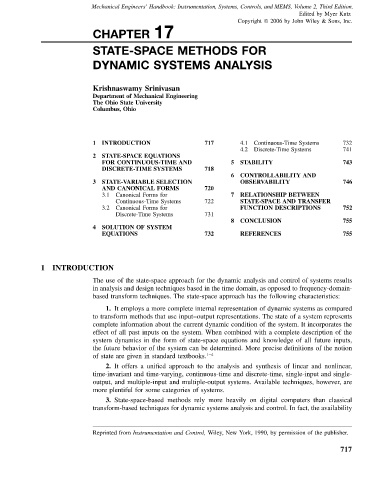Page 726 - Mechanical Engineers' Handbook (Volume 2)
P. 726
Mechanical Engineers’ Handbook: Instrumentation, Systems, Controls, and MEMS, Volume 2, Third Edition.
Edited by Myer Kutz
Copyright 2006 by John Wiley & Sons, Inc.
CHAPTER 17
STATE-SPACE METHODS FOR
DYNAMIC SYSTEMS ANALYSIS
Krishnaswamy Srinivasan
Department of Mechanical Engineering
The Ohio State University
Columbus, Ohio
1 INTRODUCTION 717 4.1 Continuous-Time Systems 732
4.2 Discrete-Time Systems 741
2 STATE-SPACE EQUATIONS
FOR CONTINUOUS-TIME AND 5 STABILITY 743
DISCRETE-TIME SYSTEMS 718
6 CONTROLLABILITY AND
3 STATE-VARIABLE SELECTION OBSERVABILITY 746
AND CANONICAL FORMS 720
3.1 Canonical Forms for 7 RELATIONSHIP BETWEEN
Continuous-Time Systems 722 STATE-SPACE AND TRANSFER
3.2 Canonical Forms for FUNCTION DESCRIPTIONS 752
Discrete-Time Systems 731
8 CONCLUSION 755
4 SOLUTION OF SYSTEM
EQUATIONS 732 REFERENCES 755
1 INTRODUCTION
The use of the state-space approach for the dynamic analysis and control of systems results
in analysis and design techniques based in the time domain, as opposed to frequency-domain-
based transform techniques. The state-space approach has the following characteristics:
1. It employs a more complete internal representation of dynamic systems as compared
to transform methods that use input–output representations. The state of a system represents
complete information about the current dynamic condition of the system. It incorporates the
effect of all past inputs on the system. When combined with a complete description of the
system dynamics in the form of state-space equations and knowledge of all future inputs,
the future behavior of the system can be determined. More precise definitions of the notion
of state are given in standard textbooks. 1–4
2. It offers a unified approach to the analysis and synthesis of linear and nonlinear,
time-invariant and time-varying, continuous-time and discrete-time, single-input and single-
output, and multiple-input and multiple-output systems. Available techniques, however, are
more plentiful for some categories of systems.
3. State-space-based methods rely more heavily on digital computers than classical
transform-based techniques for dynamic systems analysis and control. In fact, the availability
Reprinted from Instrumentation and Control, Wiley, New York, 1990, by permission of the publisher.
717

